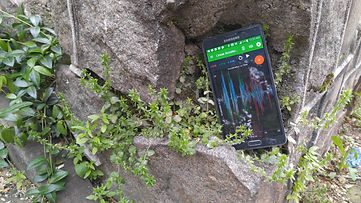LESSONS: Measurement
The majority of lesson ideas below require minimal resources other than the smartphone, and are relevant to introductory physics in high school and college. However, creative individuals are using smartphone science in more complex ways, with drones, engineering kits, and much more. Follow us on Twitter @PhysicsToolbox and see our Publications page for additional content.

Measuring Heights
What is the HEIGHT of any structure?
Try This
To measure the height of a tall object, think about the height as the side of a right-triangle. Standing a good distance away from the object, use the Orientation tool to determine the angle between the horizontal and your line of sight to the top edge of the object. To get the base of the triangle, measure the number of steps between you and the base of the object. (You can find out the length of each of your steps separately using a meter stick). This requires some understanding of trigonometry.
Related Resources

Circumference of the Earth
What is the circumference of the Earth?
Try This
Use either equinox to your advantage to measure the circumference of the Earth using a method similar to that used by Eritosthenes! On the Equinox at astronomical noon, the sun is directly overhead at the equator (where the latitude is 0 degrees). At a point not on the equator, use the GPS to determine your latitude and the Inclinometer to determine the angle of the sun at astronomical noon at your location. Considering that the Earth makes up a full 360 degrees around, use the known difference in latitude from the equator, the known distance per latitude degree, and the difference in inclination of the Sun to determine the total distance around the Earth (approximated for the Earth as a perfect sphere).

Precision and Accuracy
What is the PRECISION of our measurement tools?
Try This
Try to measure a small object (such as a leaf or coin) using various tools, including the Ruler mode. To what decimal value does the app provide? (Considering that the smartphone uses pixels, is the measurement actually that precise? Consider how smartphones make estimates about finger position). In reality, what is more accurate and precise, the smartphone or another tool?

Gait Patterns
What is the relationship between the HEIGHT and GAIT FREQUENCY for walking humans?
Try This
Try This
Attach a mobile device to your back or chest area and collect data while walking using the g-Force or Accelerometer tools. For various subjects, compare dynamic, gait, metrics, symmetry, and variability. Compare these traits in the data to physical characteristics, such as height or leg length. If desired, record video on another camera to compare data to visual observations.
Challenge Yourself
-
Create a graph of Gait Frequency vs. Height, and derive a mathematical expression for this relationship.
-
If there are any constants in these mathematical expressions, explain their significance.
-
Attach the mobile device to other parts of the body (thigh or leg). How does this data differ from that collected on your chest or back? Why?
Related Resources
-
Lesson Plan from Teach Engineering: "Identifying Gait Metrics." [External website]

Seismic Vibrations
What is the relationship between SEISMIC VIBRATION STRENGTH and DISTANCE from the "epicenter" of the shake?
Try This
Perform three different investigations from IRIS (Incorporated Research Institutes for Seismology). In these activities, use the Accelerometer tool along with a meter stick, tape, and chair or water bottle to simulate the relationship between an earthquake's magnitude and intensity. Calculate the energy released during a weight drop (magnitude) and use the accelerometer to investigate what happens to the energy as the source is moved further and further from the sensor (intensity). Examine USGS ShakeMaps to explore other factors besides event size and distance from the source to the receiver that affect the intensity (i.e. geologic structures and materials).
Challenge Yourself
-
Create a graph of Intensity vs. Distance for a "seismic event," and derive a mathematical expression for this relationship.
-
If there are any constants in this mathematical expression, explain their significance.
Related Resources
-
Lesson Plan from IRIS. "How are Magnitude and Intensity Different?" [External website]
-
Lesson Plan from IRIS. "Exploring Three-Component Seismic Data with Accelerometers." [External website]
-
Lesson Plan from IRIS. "How Hard Does the Ground Shake During an Earthquake?" [External website]